The 1953 quarter is part of the Washington quarter that was issued by the US Mint in 1953. With more than 70 years of age, the 1953 quarter is no doubt a coin to collect. If you are planning to buy a 1953 quarter or you want to sell one, this post will guide you.
Learn more about the history, composition, and value of the 1953 Washington quarter today.
What Is the 1953 Washington Quarter Made Of?
The 1953 Washington quarter is made of 10% copper and 90% silver. It has a 0.9 silver fineness level with an actual silver weight of 0.1808 oz. The weight of the coin is 6.25 grams, a diameter of 24.3 millimeters, and a reeded edge.
The Washington quarter was originally planned as a commemorative coin that should only be issued in 1932, the same bicentennial year of Washington’s birth anniversary. However, to the surprise of the US Mint, the Washington quarter was so popular among the public that they decided to officially make it the next design for the quarter from 1934 to the present day.
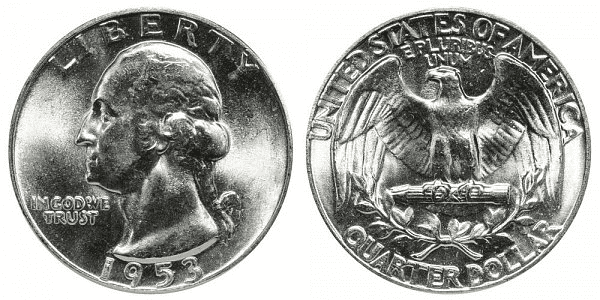
When it comes to the design of the obverse, the 1953 quarter features the face of the first US president, George Washington. Inscriptions include the following:
- LIBERTY – an important principle in the United States
- IN GOD WE TRUST – the US motto that shows the Judeo-Christian roots of the United States
- 1953 – the year of minting
On the reverse, you find the following
- UNITED STATES OF AMERICA
- E PLURIBUS UNUM – Latin adage, which means “Out of many, one.” This serves as a reminder for the Americans to stay united.
- Quarter dollar – the denomination of the coin
- Eagle – symbolizes the strength and power of the US
- Bundle of arrows – represents the readiness of the US to go to war
- Olive branch – symbolizes peace
Choosing the design for the new quarter wasn’t easy. Initially, the bicentennial committee chose Laura Gardin Fraser to design the Washington quarter. Both the committee and the Commission of Fine Arts liked the design of Fraser. However, Treasury Secretary Andrew Mellon chose the design of John Flanagan.
1953 Washington Quarter Varieties
The Denver, Philadelphia, and San Francisco mint centers worked together to produce more than 88 million quarters. There are three varieties of the 1953 Washington quarter and their main difference is their mint marks.
| Variety | Mint Location | Mintage |
| 1953 D Washington quarter | Denver | 56,112,400 |
| 1953 S Washington quarter | San Francisco | 14,016,000 |
| 1953 P Washington quarter | Philadelphia | 18,536,120 |
| 1953 Proof Washington quarter | Philadelphia | 128,800 |
| Total | 88,793,320 |
The Denver Mint produced the most number of 1953 quarters. The Denver Mint needed to produce more because the demand for coins in the western part of the US was going up.
Aside from that, the San Francisco Mint didn’t have the equipment to produce more and so, Denver needed to compensate for what was lacking.
With that in mind, here’s a deeper look at each of the 1953 Washington quarter varieties.
1953 D Washington Quarter
Year of minting: 1953
Mint Mark: D
Place of minting: Denver
Quantity produced: 56,112,400
Face Value: $0.25 (twenty-five cents)
Price: starts at around $4.45 and $7 (circulated condition)
Mass: 6.30 grams
Edge: Reeded
Designer: John Flanagan
Composition: 90% Silver and 10% Copper
Diameter: 24.30 mm
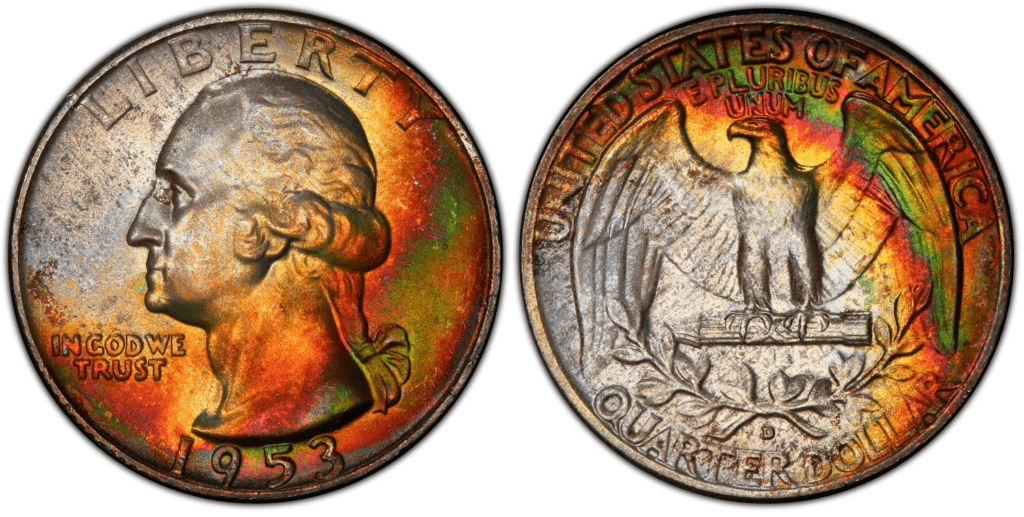
The Denver Mint produced almost 56 million 1953 silver quarters, which is the highest mintage among the three mint centers. Although there are a lot of 1953 D quarter coins, it is difficult to find them in top grades.
1953 S Washington Quarter
Year of minting: 1953
Mint Mark: S
Place of minting: San Francisco
Quantity produced: 14,016,000
Face Value: $0.25 (twenty-five cents)
Price: starts at around $4.45 and $7 (circulated condition)
Mass: 6.30 grams
Edge: Reeded
Designer: John Flanagan
Composition: 90% Silver and 10% Copper
Diameter: 24.30 mm
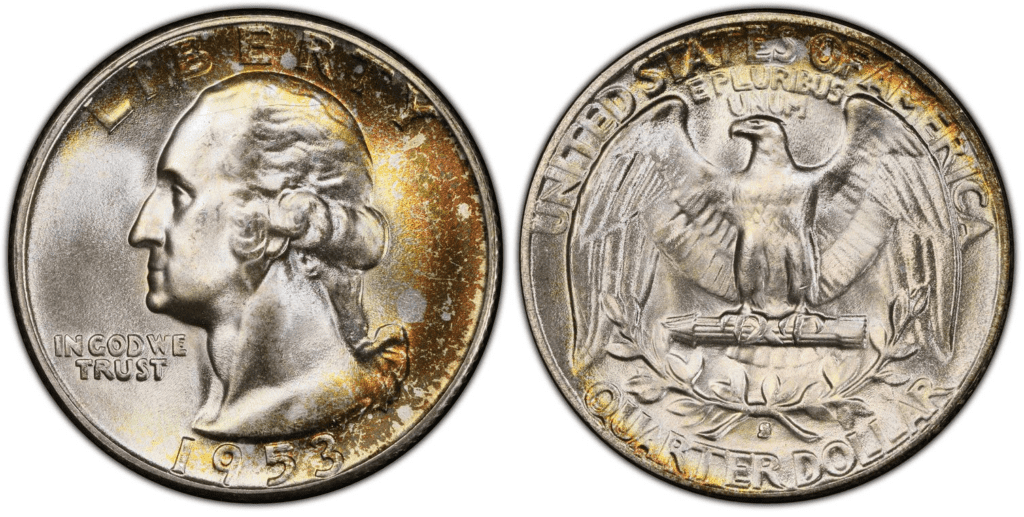
The San Francisco Mint produced more than 14 million quarters in 1953. It produced the least number of 1953 quarters. As this might be the case, it is easier to find 1953 S quarters in top grades compared to 1953 P and 1953 D varieties.
1953 P Washington Quarter
Year of minting: 1953
Mint Mark: S
Place of minting: San Francisco
Quantity produced: 18,536,120
Face Value: $0.25 (twenty-five cents)
Price: starts at around $4.45 and $7 (circulated condition)
Mass: 6.30 grams
Edge: Reeded
Designer: John Flanagan
Composition: 90% Silver and 10% Copper
Diameter: 24.30 mm
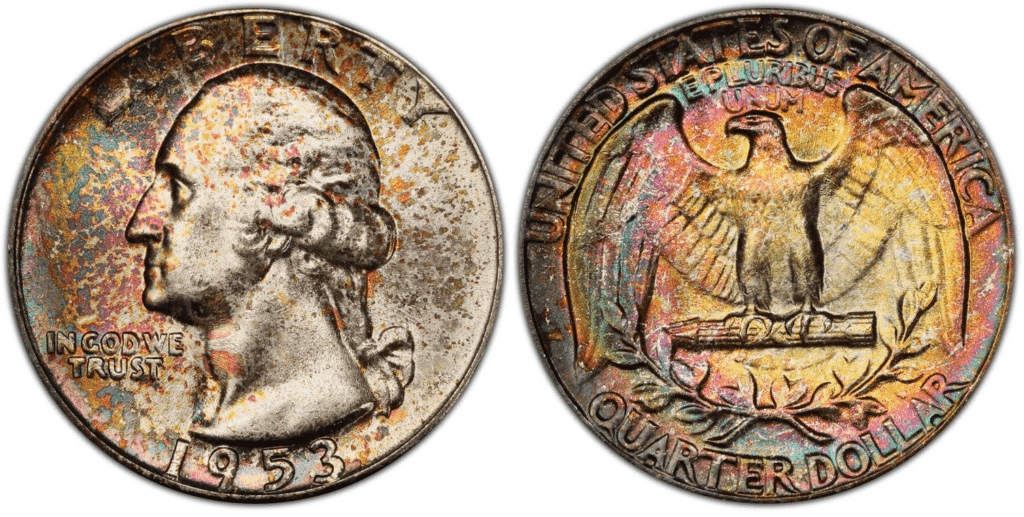
The Philadelphia Mint produced more than 18 million quarters in 1953. The coins from the Philadelphia mint were poorly struck due to the use of overused dies. That’s why most 1953 P quarters lack details. They look blurry and soft in appearance.
It is rare to find 1953 quarters in top condition. That’s why, if you have one of these in grades up to MS 67, you can expect that it will be worth a lot of money.
1953 Proof Washington Quarter
Year of minting: 1953
Mint Mark: S
Place of minting: San Francisco
Quantity produced: 128,800
Face Value: $0.25 (twenty-five cents)
Price: starts at around $13 (uncirculated condition)
Mass: 6.30 grams
Edge: Reeded
Designer: John Flanagan
Composition: 90% Silver and 10% Copper
Diameter: 24.30 mm
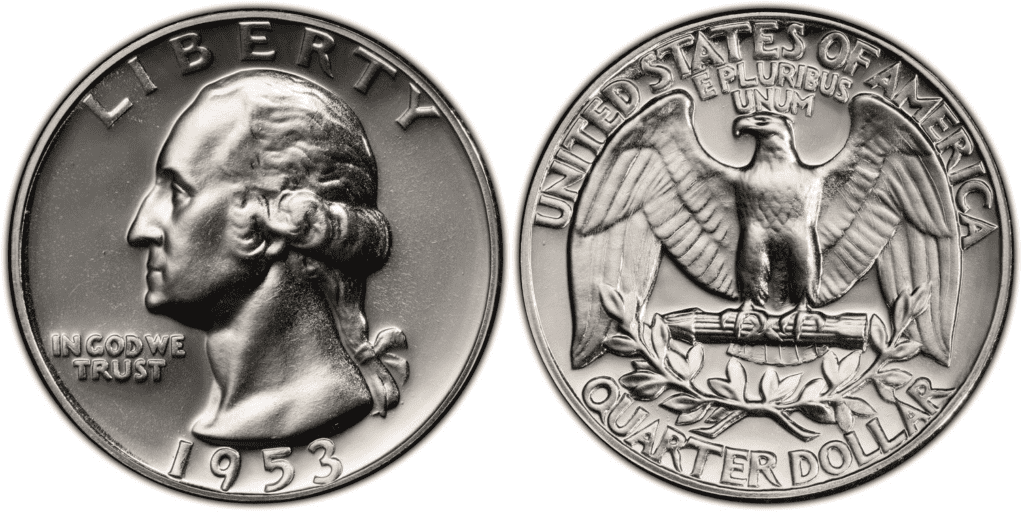
The 1953 quarters from Philadelphia Mint also include proof coins. Proof coins are more beautiful and detailed in their design. Because they need more time and energy to produce, there are always fewer in number than the regular coins. Aside from that, proof coins are mainly made for collectors.
List Of 1953 Washington Quarter Errors
The 1953 Washington quarter has its fair share of error coins. Since error coins are rare and they are not common in circulation, they have always caught the attention of avid coin collectors. Not only that, but error coins can be unique in their appearance, which can easily increase their value.
Here are a few examples of 1953 Washington quarter errors.
Repunched mint mark (RPMs)
The most common error in 1953 quarter coins would be the repunched mint mark (RPM) error. The mint mark is struck to the coin separately. It is not part of the original die. That’s why you will notice that the Philadelphia Mint can usually skip adding mint marks while the Denver and San Francisco mint centers would choose to add their mint marks.
Here’s an example of an RPM error on a 1953 quarter:

RPMs happen when the mint mark is punched on the coin twice. If the second strike was punched on a different angle, the RPM error would be more noticeable. It will show itself as a doubled or blurry mint mark.
Clipped planchet error
The clipped planchet error happens during the cutting of the blank coin. The metal sheet gets into the feeder in the wrong alignment. Thus, the blank coin is cut including a portion of the previous blank coin. This then leads to a clipped planchet error.
Doubled die error
The doubled die error happens when the die hits the planchet twice. The second strike produces a doubling effect on the engraved elements on the coin. The more prominent the doubled die error is, the more it becomes valuable.
How Much Is The 1953 Washington Quarter Worth Today?
The 1953 Washington quarter has a face value of 25 cents. Since this coin is made of silver, it has a higher melt value, which is $3.9678 (at the time of this writing). The melt value of the Washington quarter can increase or decrease depending on the market value of silver.
Buying a circulated 1953 quarter can cause around $4.40 to $7. However, there are those 1953 quarters that are more valuable than others.
To help you get an idea of how much they can be sold for, here’s an auction record table for each of the variety:
| Coin | Condition | Grade | Sold date | Sold by | Value |
| 1953 Proof Washington quarter | Superb Gem Uncirculated | PR 69 (Deep Cameo) | January 24, 2001 | Heritage Auctions | $15,600 |
| 1953 S Washington quarter | Superb Gem Uncirculated | MS 68 | January 15, 2023 | Heritage Auctions | $5,040 |
| 1953 D Washington quarter | Superb Gem Uncirculated | MS 67 | December 4, 2008 | Heritage Auctions | $4,744 |
| 1953 P Washington quarter | Superb Gem Uncirculated | MS 68 | November 15, 2018 | eBay | $4,500 |
How Does The Grading System Work?
The 1953 quarter is graded using the Sheldon Scale. By looking at its overall appearance, color, and preservation, an appraiser would assign a grade to the coin, which can be from 1 to 70.
Aside from the numerical grade, an appraiser would also choose an adjective to describe the coin, which can be Poor, Fine, Circulated, and Uncirculated, to name a few.
Professional numismatists joined together in the 1970s and established CoinGrading standards. These numismatists now assign grades at key places on the seventy-point scale, using the most regularly utilized numeric points in conjunction with the original adjective grade. The following are the most common coin grades:
-
-
- (P-1) Poor – Indistinguishable and probably damaged; if used, must have a date and mintmark; otherwise, rather battered.
- (FR-2) Fair – Nearly smooth, but without the damage that a coin graded Poor often possesses. The coin must have enough detail to be identified.
- (G-4) Fair – Inscriptions have merged into the rims in some areas, and important elements have been mostly erased.
- (VG-8) Very Good- A little weathered, but all of the primary design elements are visible, albeit faintly. There is little if any, central detail left.
- (F-12) Good – The item is very worn, yet the wear is even, and the overall design details stand out clearly. Rims are almost completely isolated from the field.
- (VF-20) Very Fine – Moderately weathered, with some finer features still visible. The motto or all letters of LIBERTY are readable. Both sides of the coin have entire rims that are separated from the field.
- (EF-40) Extremely Fine – Gently used; all gadgets are visible, and the most important ones are bold. The finer details are bold and clear, however, light wear may be seen.
- (AU-50) Uncirculated – Slight evidence of wear on the coin’s design’s high points; may have contact marks; eye appeal should be adequate.
- (AU-58) Uncirculated Choice – Slight traces of wear, no severe contact marks, almost full mint shine, and great eye appeal.
- (MS-60) Mint State Basal – Strictly uncirculated; no indication of wear on the coin’s highest points, but an unsightly coin with reduced luster, visible contact marks, hairlines, and other flaws.
- (MS-63) Mint State Acceptable – Uncirculated, but with contact scratches and nicks, little reduced shine, but otherwise appealing appearance. The strike is weak to average.
- (MS-65) Mint State Choice – Uncirculated with great mint shine, very little contact blemishes, and exceptional eye appeal. The strike is unusually severe.
- (MS-68) Mint State Premium Quality – Uncirculated with superb luster, no obvious contact marks to the naked eye, and exceptional eye appeal. The strike is quick and appealing.
- (MS-69) Almost Perfect Mint State – Uncirculated with perfect brilliance, a sharp and appealing strike, and extremely good eye appeal. A near-perfect coin with minor imperfections in the planchet, strike, and contact markings (seen only under 8x magnification).
- (MS-70) Mint State Perfect – Under 8x magnification, there are no tiny imperfections discernible; the strike is crisp, and the coin is perfectly centered on a beautiful planchet. Rarely seen on a coin, this coin is bright and whole, with original luster and exceptional eye appeal.
-
Where To Buy Or Sell 1953 Washington Quarter?
The 1953 Washington quarter is an old coin. So, you might have a hard time finding them. The quickest way for you to start your search would be online. You can head to Amazon, eBay, and Etsy to find the right coin for you.
Aside from online, head to coin shops and antique stores. It’s worth a try and see if they have 1953 Washington quarter coins. Auction houses might also help you provide more choices.
FAQs
How much does a 1953 quarter weigh?
The 1953 quarter weighs 6.30 grams. The silver quarters are heavier compared to the quarters today, which are only 5.67 grams.
What was the 1953 quarter made out of?
The 1953 quarter is made of 90% silver and 10% copper.
